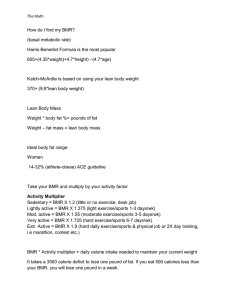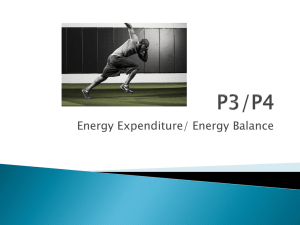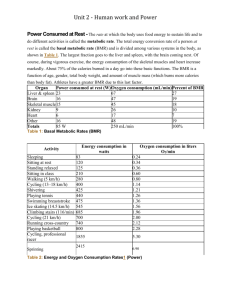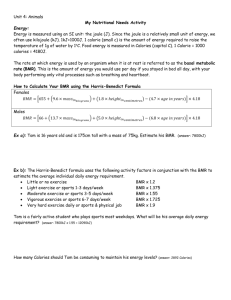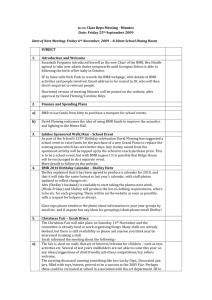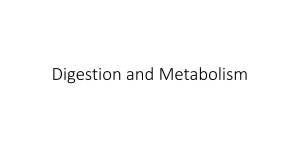Human Nutrition session 4
advertisement
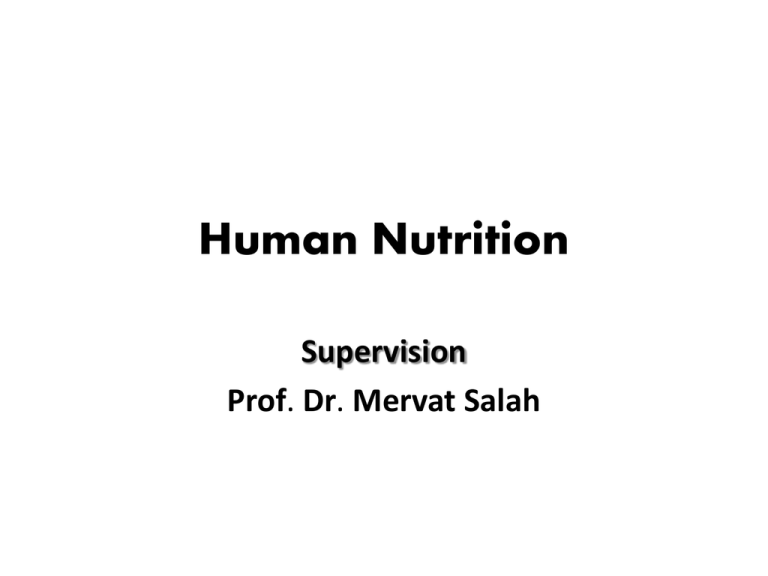
Human Nutrition Supervision Prof. Dr. Mervat Salah Intended Learning Outcomes - By the end of this lecture, students will have a general overview on the body composition. - As well as some basics of energy. Facts about Body weight Body is composed – water, fat, muscle, bone,minerals Composition varies with age Controlled by hormones, diet, exercise, stress etc. Body Mass Index = wt (kg) / ht 2 (m) Ideal range = 19 – 23 for Indians Over weight BMI is > 23 – 26, Waist to Hip ratio (WHR) – Central obesity obese >27 Ideal = 0.8 Nutrition & wellness - Nutritional perspective. Drmervat salah. Body Mass Index indicator of health risk eg – 75 kg / 1.7 X 1.7 m = 26 BMI class < 18.5 18.5 - 22.9 23 - 24.9 > 25 Presumptive diagnosis Underweight Normal Overweight Obese Nutrition & wellness - Nutritional perspective. Drmervat salah. Composition Of The Body A normal chemical composition for a man wieghing 65kg is protein……….11kg……17 % fat………………9kg.......13.8% cho……………..1kg…….1.5 % water………….40kg…….61.6% minerals………..4kg……..6.1% Functions Of The Food There are several biological functions of food : 1- Source of energy (fat and cho ) 2- building material ( pt and ca, ph ) 3- regulating and protective agent NUTRIENT BODY FUNCTION FOOD SOURCES Carbohydrate Energy, protein sparing – 4kcal/g Cereals, pulses, veg, fruits Protein Growth, repair, energy, enzymes, antibodies, hormones Pulses, meat, fish, milk products, egg, cereals Fat (lipid) Energy, EFA, fat-sol vit, insulation. Fats, oils, meat, fish, nuts dairy products Minerals Skeletal, growth , blood clotting, immunity Vitamins Vision, immunity, bone, teeth, metabolism Dairy, GLV, fruits, whole grains meat, veg, legumes, organ meat nuts Nutrition & wellness - Nutritional perspective. Dr. Mervat salah NUTRIENT SUPPLY FOOD 1. 2. 3. 4. 5. 6. 7. 8. Cereals Pulses Milk Vegetables Oils / fats Fruits Sugar Meat Amount Energy Protein CHO g/ml Kcals g g 100 100 100 100 20 100 20 100 350 340 65 35- 55 180 30-55 80 80-140 6-12 18-25 3-5 1-2 1-1.5 12-22 60-70 60 8 8-15 10-15 20 - Fat g 1-2 1-5 4-6 20 3-13 Energy Value Of Food 1gm of Fat give 9 calories 1gm of Protein give 4 calories 1gm of carbohydrates give 4 calories carbohydrates and fats are the preferred energy sources , protien will be used for energy if cho and fats are not available in the diet and may build up of toxic byproduct (ketones) in the blood . Sources of Fuel Protein, Fat, Carbohydrates Substrate choice depends І Intensity & duration of exercise Fitness level Dietary intake Energy is used in 3 ways 1 – Digesting food 10% 2 - Physical activity 25% 3 - Basal Metabolic rate ( BMR) 65% BMR – all functions that support life 24 hours Can’t change the percent But You can change your energy demand Basal metabolic rate(BMR) (BMR) is affected by several factors : 1-Body composition and surface area . 2- Sex women lower than men . 3-Age the highest rate during infancy . 4- Body temperature increase in cold fever 5-Physiological status decrease in starvation ,increase in illness . 6- Effects of hormones thyroxin Energy Requirements Energy requirements are affected by : - Body size -Basal metabolic rate -Activity -Pregnancy (300cal) -Lactation (500 cal) -Age -Climate (worm climate need less cals ) Total Daily Energy Requirement TDR TDR BMR EEA SDA = BMR + EEA + SDA = total daily requirements = basal metabolic rate = energy expenditure of activity = specific dynamic action of food BMR For adults BMR = Ideal Body weight x 25 decease 2% every 10 years after age 20 For age less than 20 years BMR =1kcal / m2 /hr - or - 55 – age (yr) the area of the body from tables Energy Expenditure Of Activity -EEA deferent from one to one , -the average rang 1.1 to 8.4 cal /kg /hr -the easy way is : no active = 400 to 800 cal or 20%of BMR light active=800 to1200 cal or 30% of BMR moderate =1200 to1800 cal – 40%of BMR very active=1800 to 3000cal _50%of BMR Specific Dynamic Effect Of Food It is the calorigenic effect of the food or the calories need for the digestion absorption transport process of the food protein consume 15 % of its given cals carbohydrates 6% of its given cals fats consume only 2% of its given cals Assignment Rana fathi el zemrany Recommended text book Manual dietetic book

